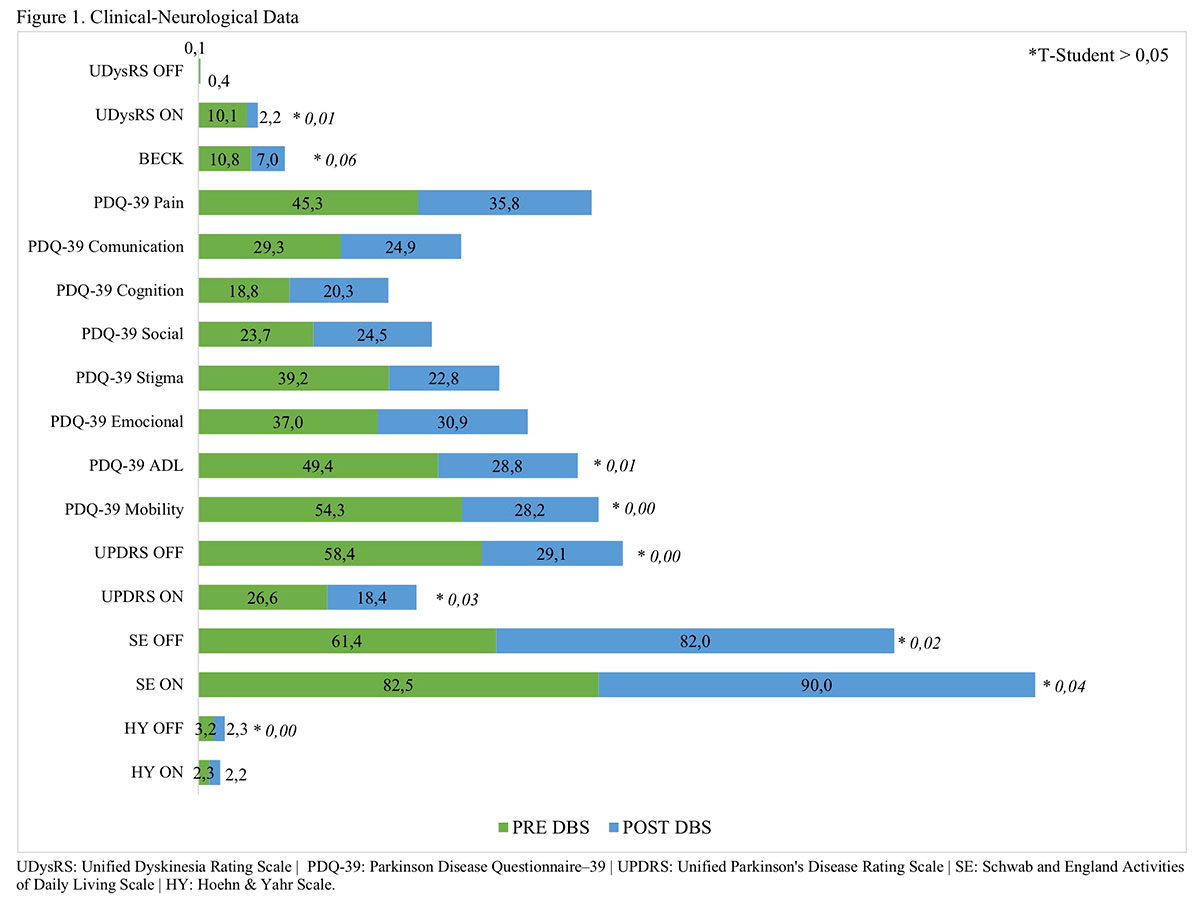Session Information
Date: Wednesday, September 25, 2019
Session Title: Surgical Therapy
Session Time: 1:15pm-2:45pm
Location: Les Muses Terrace, Level 3
Objective: To report the results of one-year follow-up of subthalamic deep brain stimulation in Parkinson’s disease on 19 patients bilaterally implanted at Federal University of São Paulo.
Background: Deep Brain Stimulation of the Subthalamic Nucleus (STN-DBS) is an effective treatment for Parkinson’s disease (PD). The short and long-term benefits of bilateral stimulation in patients with advanced Parkinson’s disease have been well documented.
Method: We conducted a one-year prospective study of the 19 subjects treated with bilateral stimulation of the subthalamic nucleus. Patients were assessed preoperative and also follow-up at 12 months after DBS, applying the Unified Parkinson’s Disease Rating Scale (UPDRS) and the Unified Dyskinesia Rating Scale (UDysRS). The quality of life was assessed by the Parkinson’s Disease Questionnaire-39 Items (PDQ-39), and the presence of mood changes was determined by applying Beck Depression Inventory (BDI). At 12 months post-DBS in the optimal setting compared to pre-DBS and subjects were tested in two conditions (on and off DBS).
Results: The study enrolled 19 patients. The mean age of onset was 55.7 ± 10.1 years, and the mean disease duration was 10.5 ± 5.1 years. We analyses the influence of DBS surgery compared the pre-DBS with post-DBS performance at 12 months, when patients were on their optimal stimulation setting. Before surgery motor symptoms on the UPDRS in the off-medication showed mean 58.3 ± 16.2, and on-medication the score was 26.5 ± 11.8. At 12 months follow-up STN-DBS the UPDRS mean was 29.1 ± 10.9 in off-medication and on-medication was 18.3 ± 10.2. With stimulation, UPDRS in the off-medication condition improved by 50.1% after 12 months. There was an overall 37.4% reduction in the LED intake after one year of stimulation. After 12 months, the quality of life of the PDQ-39, including mobility and activities of daily living improved respectively, 48.2% and 41.7%. The depression scale BDI before DBS was 10.8 ± 6.6 points, and after 12 months BDI mean was 7.0 ± 5.3. Clinical data of the patients are summarized in Figure 1.
Conclusion: This study demonstrated positive benefits in motor and mood function after 12 months follow-up of STN-DBS. The improvements in motor outcomes, activity of daily living observed were similar to those reported by the others DBS study. Bilateral subthalamic nucleus stimulation is effective in the treatment of PD.
References: [1] Williams A, Gill S, Varma T, Jenkinson C, Quinn N, Mitchell R, et al. Deep brain stimulation plus best medical therapy versus best medical therapy alone for advanced Parkinson’s disease (PD SURG trial): a randomised, open-label trial. Lancet Neurol 2010;9:581-91. [2] Deuschl G, Schade-Brittinger C, Krack P, Volkmann J, Schafer H, Botzel K, et al. A randomized trial of deep-brain stimulation for Parkinson’s disease. N Engl J Med 2006;355:896-908. [3] Schuepbach WM, Rau J, Knudsen K,Volkmann J, KrackP,Timmermann,et al. Neurostimulation for Parkinson’s disease with early motor complications. N Engl J Med 2013;368:610-22. [4] Krack P, Batir A, Van Blercom N, Chabardes S, Fraix V, Ardouin C, et al. Five-year follow-up of bilateral stimulation of the subthalamic nucleus in advanced Parkinson’s disease. N Engl J Med 2003;349:1925-34. [5] Hamani C, Richter E, Lozano A. Bilateral subthalamic nucleus stimulation for Parkinson’s disease: a systematic review of the clinical literature. Neurosurgery 2005; 56:1313-1324.
To cite this abstract in AMA style:
L. Barcelos, M. Tosin, M. Marinho, C. Silva, R. Saba, S. Silva, V. Borges, H. Ferraz. One-year follow-up of subthalamic deep brain stimulation in Parkinson’s disease [abstract]. Mov Disord. 2019; 34 (suppl 2). https://www.mdsabstracts.org/abstract/one-year-follow-up-of-subthalamic-deep-brain-stimulation-in-parkinsons-disease/. Accessed December 13, 2025.« Back to 2019 International Congress
MDS Abstracts - https://www.mdsabstracts.org/abstract/one-year-follow-up-of-subthalamic-deep-brain-stimulation-in-parkinsons-disease/

